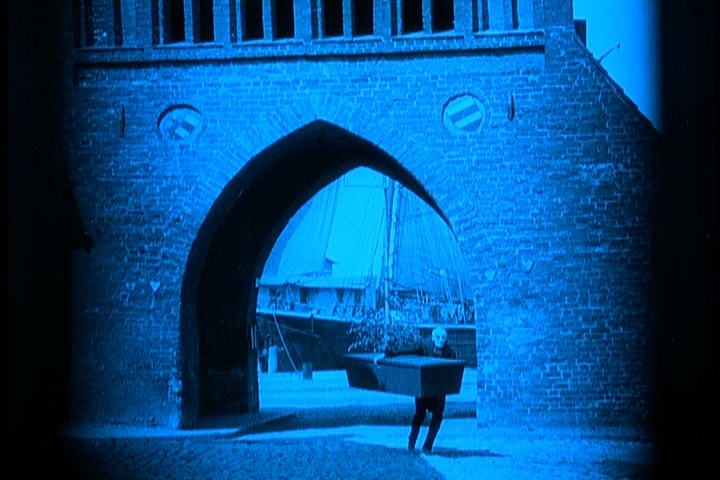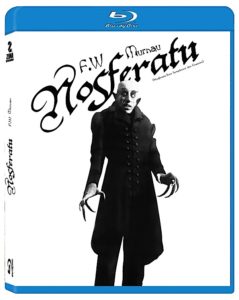
Nosferatu Stays Silent
Since the teen and I reviewed a recent ghost story for our first contribution to Crash Palace Productions, I thought it might be prudent to expose the child to some classics. But where to start? The contemporary ones like Nightmare on Elm Street and Friday the 13th as preparation for the Scream series? My personal favorites? Or perhaps a chronological approach— F. W. Murnau’s Nosferatu (1922) has special meaning to me. I mentioned it to her.
“Hey, Eva, how would you feel about a silent horror movie? It’s almost 100 years old.”
Silent. Movie.
The confusion clouded her face as if I had suggested that phones were once attached to the wall in the house and you couldn’t tell who was calling unless you picked it up.
When my husband and I had to explain the concept of a silent movie, we knew she had to watch it. I suspected she would hate me for it. My husband believed her love of music would attract her to the score. She almost fell asleep several times. Of course, we had run three miles at the gym and feasted on Dunkin’ Donuts immediately before our matinee.
Nosferatu is the earliest surviving film adaptation of Bram Stoker’s Dracula and a fine example of German Expressionism. Stoker’s heirs sued the filmmakers and demanded that the film be destroyed. Somehow, it survived.
The film opens by explaining that the vampire was the source of the plague in Bremen. The actors do a respectable job for the early days of the industry. Max Shreck as Count Orlock (Dracula) appears appropriately creepy to the tee. Long arms, nails and teeth and a dark coat convey the look that still makes a person cringe a century later. Yet, my favorite scene rings of comedy, not horror. When Orlock arrives in Bremen, he carries his coffin throughout town to his new home. There are several scenes of the strange-looking vampire carting a coffin as if it were his groceries. The teen enjoyed that, too. She also enjoyed Harker’s escape from the castle, ripping bedsheets and tangling them into a rope, although the camera work was choppy.
Despite its lack of sound, the film makes impressive use of not only dialogue screens but many other ways to convey spoken information. The film presents newspaper clippings, ships logs, letters, old manuscripts (“The Book of the Vampire”), and official notices much in the same way the original book used journals as a means of storytelling. And I also like to note this film portrays Harker’s wife, Nina (played by Greta Schröder) as the woman pure enough in heart to destroy the vampire. A woman defeats the evil villain in an early 20th century film, not a time when one expects a female to save the world. Isn’t that Buffy’s job?
And some of the lines are indeed gems. When a locket falls open, Count Orlock asks Jonathon Harker, “Is that your wife? What a lovely throat.”
To the teen, eighty minutes of silent movie stretched into eternity. She found the acting a tad distracting because the actors kept looking straight into the camera, which diluted the potential for developing a sense of fear. She considered it a pure presentation of the Dracula tale (now keep in mind she hasn’t read Dracula but is familiar with modern pop culture interpretations).
She missed the fact that Renfield was both Harker’s boss and the mental patient. She had suspicions since they seemed the same, but she wasn’t sure. Now that I have confirmed it, she says that presents some questions.
From a musician’s perspective, Eva said the score was full of good music, but it didn’t always match the action on the screen. When the music was peaceful, for example, Count Orlock was sneaking into Harker’s room in the castle. She would have picked something more suspenseful.
All in all, the exposure to silent horror seemed a good one in this mother’s perspective. The teen managed to pay attention and now the stage has been set to delve deeper into Dracula stories. Should we visit my old friend Bela Lugosi next? Or perhaps it would be best to consider Shadow of the Vampire… and its connection to this film.

The Plot Sickens: Want more from Angel Ackerman and Eva Parry? Then find out what they think of I am the Pretty Thing that Lives in the House!
Crash Palace Support Team
 Angel Ackerman and Eva Parry
Angel Ackerman and Eva Parry
After a fifteen-year career in print journalism, Angel Ackerman has studied world history, (specifically post-colonial Francophone Africa, Muslim relations, and contemporary Western politics) and traveled several continents. Her recent publications include the poem This Paris in StepAway magazine, an essay on the weather and travel on the Horn of Africa in Rum Punch Press, academic encyclopedia entries on Djibouti, a review in Global Studies South on a book examining famine in Somalia, book reviews from eons ago for Hippocampus Magazine and an upcoming essay on chickens. Follow her on Twitter.
Eva Parry will enter high school this fall but has already spent a season in the low brass section of the marching band carrying a sousaphone. When not irritating her mother by piling as many clothes and candy wrappers as possible on her bedroom floor, she explores various writing forms and antagonizes her cats. She has known Billy Crash most of her life and never stops making noise or talking, which once resulted in her missing a catch in a game of Frisbee and taking a Frisbee in the mouth.
(Still from Nosferatu via Streamline.)
